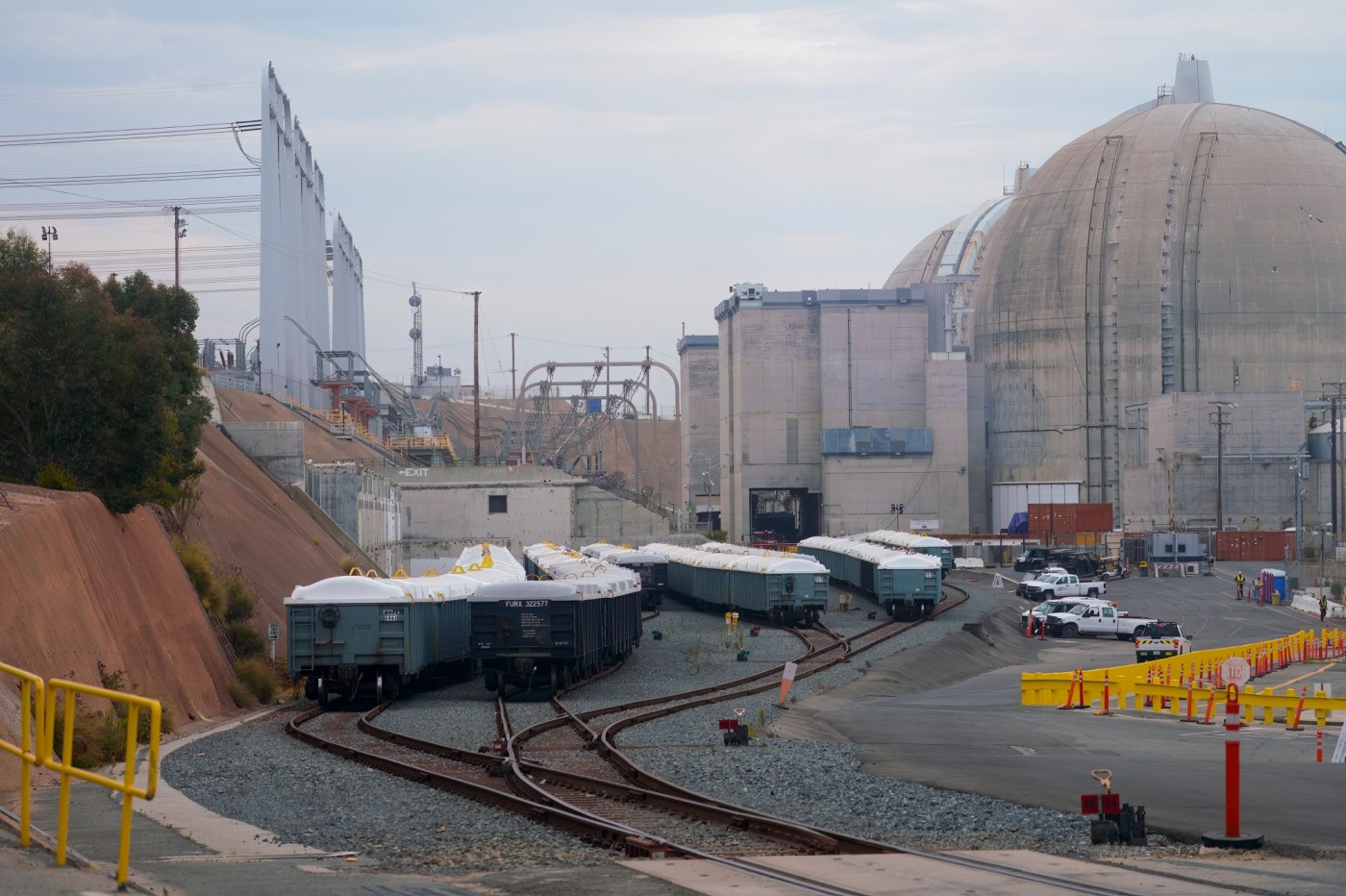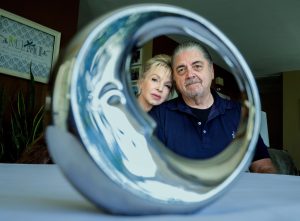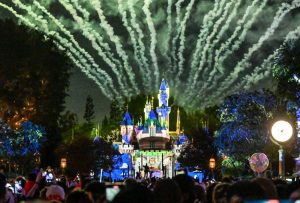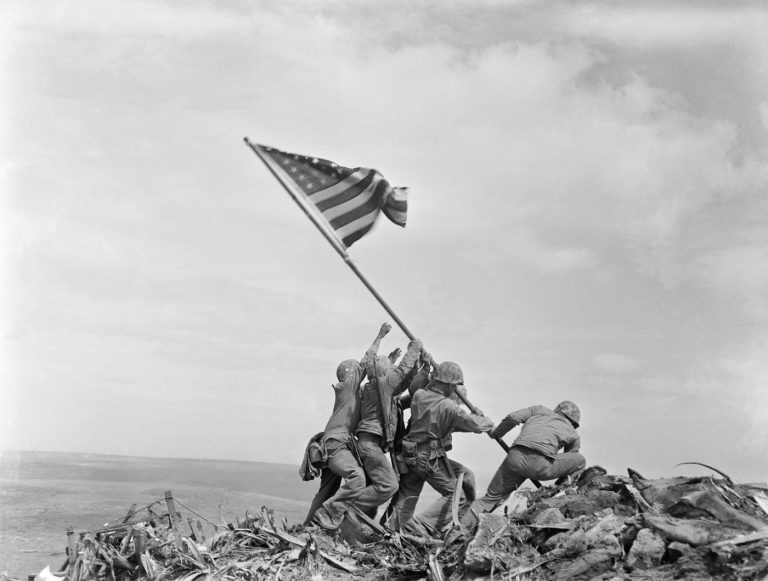Some of the heaviest and most troublesome radioactive material to be removed from the decommissioned San Onofre Nuclear Generating Station has only one exit – the imperiled railroad corridor north through San Clemente.
Landslides have forced the closure of the seven-mile stretch of railroad through San Clemente multiple times in recent years. Transit planners are working to determine how much longer the seaside tracks can be maintained where they are, and whether someday they should be relocated inland.
Some residents, mostly people who live near the tracks, have suggested the entire segment from downtown San Diego through southern Orange County is too costly to maintain and should be shut down. That is unlikely, though, given its importance as the region’s only railroad connection to the rest of the United States.
Any loss of train transit through San Clemente also could further delay the removal of radioactive material from the decommissioned nuclear power plant at San Onofre. Some of the components are too large and too heavy to ship by any other method than rail.
Virtually all the nuclear fuel used in the past 50 years at San Onofre remains in storage at the site. Dozens of other U.S. nuclear plants are in the same situation. The used fuel is called “spent” and not “waste,” because the industry’s original intent was to reprocess or recycle it, an idea that proved impractical.
Reprocessing removes some of the most radioactive material from the fuel, but it creates a concentrated form of waste that is more difficult to handle.
The federal budget for fiscal 2024 included $93 million to help locate, design and build an interim storage facility for the spent nuclear fuel from plants across the country.
“As the representative for the area in and around the San Onofre Nuclear Generating Station, I know how important it is to find a solution for our nation’s spent nuclear fuel,” said Rep. Mike Levin, D-San Juan Capistrano, in an announcement in mid-July. “That’s why I’ve made this issue a top priority since joining Congress.”
Levin recently helped obtain an additional $55 million to advance spent fuel management programs.
“This funding brings us one step closer to getting the spent fuel out of San Onofre and to a safe home,” Levin said. “I’m proud to have secured the funding to help restart DOE’s process to find a location for our spent fuel, and I will continue fighting for the resources we need until the job is finished.”
Part of the recent funding was used to design and build a special railroad car large enough to carry shipments weighing up to 480,000 pounds, or 240 tons, more than the Statue of Liberty. Known as the Atlas rail car system, it is intended to carry spent fuel from plants across the United States to a central storage location.
Vertically stored casks of spent fuel remain in the dry storage facility at the decommissioned San Onofre Nuclear Generating Station. (Nelvin C. Cepeda / The San Diego Union-Tribune)
Final testing of the proposed rail transportation system wrapped up last fall with a 1,680-mile, round-trip journey from Pueblo, Colo., to Scoville, Idaho.
The Atlas system could be used at San Onofre, but other systems are available, said Manuel Camargo, principal manager for strategic planning for Southern California Edison, the plant’s operator.
“It’s over-built,” Camargo said of the new system. “Moving spent nuclear fuel is a known process. We in the United States have been moving spent fuel since the 1950s.”
San Onofre initially shipped 270 spent fuel assemblies from its original Unit 1 reactor by rail before the federal government halted the process in the early 1970s, he said.
The DOE is looking at two possible interim storage sites, one in New Mexico and one in Texas. However, like the long-studied, but never-approved permanent repository proposed for Yucca Mountain, Nev., any interim storage site faces an uphill battle for approval.
Despite the recent advances, the prospect of a central storage facility for spent nuclear fuel remains distant.
“No spent fuel is going anywhere … probably for decades in the future,” said Edwin Lyman, an expert on nuclear power and safety at the Union of Concerned Scientists.
The national political climate makes it unlikely that a federal site can be approved anytime soon, Lyman said Tuesday. When and if one is eventually approved, the casks loaded with fuel will be moved by rail.
“All things being equal, rail transport is safer,” he said. “The obvious fact is that it reduces the number of shipments, but then the quantity of material in each shipment increases, so you need to worry about that.”
It the meantime, the railroad route through San Clemente faces an uncertain future.
The beach near the tracks has eroded badly in recent years. The Orange County Transit Authority, which maintains the route, has added tons of rocks to protect the rails. Also, a federal sand replenishment project completed earlier this year widened some of the narrowest beaches near the city’s public pier.
Yet waves still crash onto the steel tracks in San Clemente during the highest tides of the year, and the threat is certain to increase with the rising sea level.
Any effort to reroute the tracks away from the coast is likely to face opposition. A similar situation exists in Del Mar, near San Diego, where about 1.7 miles of the right-of-way owned by North County Transit District follows a high, fragile bluff above the beach.
Regional planners say the only solution in Del Mar is to bore a tunnel beneath the small, wealthy hillside town. Yet residents there have vowed to fight it, saying it would increase their exposure to noise, vibrations and other hazards of the trains.
Demolition underway of the control building for Units 2 and 3 underway Thursday at the San Onofre Nuclear Generating station. (Nelvin C. Cepeda / The San Diego Union-Tribune)
More than 310 million tons of waste has been shipped by rail and truck from the decommissioned San Onofre plant so far, said a spokesperson for Southern California Edison. That’s roughly about one-third of all the material expected to leave the plant during the decommissioning process.
BNSF freight trains take rail cars loaded with concrete rubble, steel scraps and other waste from the plant once a week, usually leaving between 9 and 11 Wednesday nights.
All kinds of things used at the power plant can become radioactive waste, from the lightweight gloves worn by technicians to steel parts of the reactor weighing tons.
Most of the waste generated so far from the demolition is considered Class A, the lowest level of radioactive material. Nearly all of that goes by rail to a disposal site in Clive, Utah. Class B and C waste, also with low-level radioactivity, goes to a site in Andrews, Texas.
Most of the major components of the San Onofre Nuclear Generating Station, or SONGS, arrived by rail. Those include the reactor vessels and steam generators, and they will leave by rail.
The Unit 1 reactor vessel, which was decommissioned before Units 2 and 3, was dismantled and placed inside a huge steel container that was then filled with grout. That package weighed 770 tons, according to Edison, or roughly the amount of three Statue of Liberties.
The vessel package, 38.5 feet long and 15.5 feet in diameter, was lifted onto a 36-axle Schnabel railroad car and, on the night of May 24, 2020, it left San Onofre for its final resting spot in Apex, Nevada. The trip took four days to cover 366 miles at a top speed of 15 mph.
Similar journeys are planned for the Unit 2 and 3 reactor vessels sometime in the next few years, depending on the speed of the decommissioning process.
Related Articles
Opinion: Bay Area faces another affordability crisis, this time with natural gas
Five tips to help keep your utility bill somewhat manageable this summer
Coming to your electric bill: Monthly charge to extend Diablo Canyon’s life
California electric bills have essentially doubled over the past decade
PG&E profits soar, powered by increases in electricity and gas revenue
Under ideal circumstances, with the shipments of three casks loaded with fuel rod assemblies every two weeks, the task could be completed in about two years, according a DOE conceptual transportation plan completed in 2021.
A more conservative estimate calls for three casks leaving San Onofre every eight weeks. That would complete the removal in about seven years, according to the plan.
Highway truck shipments of spent fuel are possible but highly unlikely, according to the DOE.
A specialized vehicle with a trailer up to 90 feet long, 12 feet wide and 16 feet tall would be required. The total weight could reach 210 tons, excluding the spent fuel or other radioactive cargo. Road closures usually are necessary for vehicles of that size to pass.
“This mode choice significantly increases the number of shipments required to de-inventory the SONGS site,” the DOE plan states. “Heavy-haul truck transport also presents significant logistical challenges because it necessitates the temporary closure of public roadways and allows for travel only at low speeds.”
When the plant was operating, up until January 2012, fresh, enriched uranium fuel rods arrived at the plant on trucks. The new rods are only slightly radioactive, and people can safely stand next to them or even touch them with gloved hands.
However, the rods grow gradually more radioactive as they are used in the reactor. When removed from the reactor at the end of their useful life, usually about two years, the rods are highly radioactive and, if unshielded, can deliver a lethal dose within seconds to anyone standing within about a foot.
The irradiated rods must be stored underwater for about five years after they are removed from the reactor, until the radiation has diminished enough to place them in dry storage containers.
Spent fuel rods in storage continue to grow less radioactive, but the process is slow. About 40 percent of the radioactivity comes from the element cesium-137, which has a half-life of 30 years, meaning its radioactivity is reduced by half every 30 years.
Until a national repository is chosen, the spent fuel is relatively safe at San Onofre, Lyman said.
“Spent fuel, stored in dry casks (and) well maintained and monitored, poses a relatively low accident risk,” he said. The facilities are designed to withstand natural disasters such as an earthquake or a tsunami.
One exception is the possibility of a terrorist attack, he said. An explosion at the storage site could spread radioactive material across a wide area.
“You have to protect that material from being attacked … and the industry doesn’t want to spend a lot of money guarding this thing just sitting there,” Lyman said. “That’s the one outlier.”












